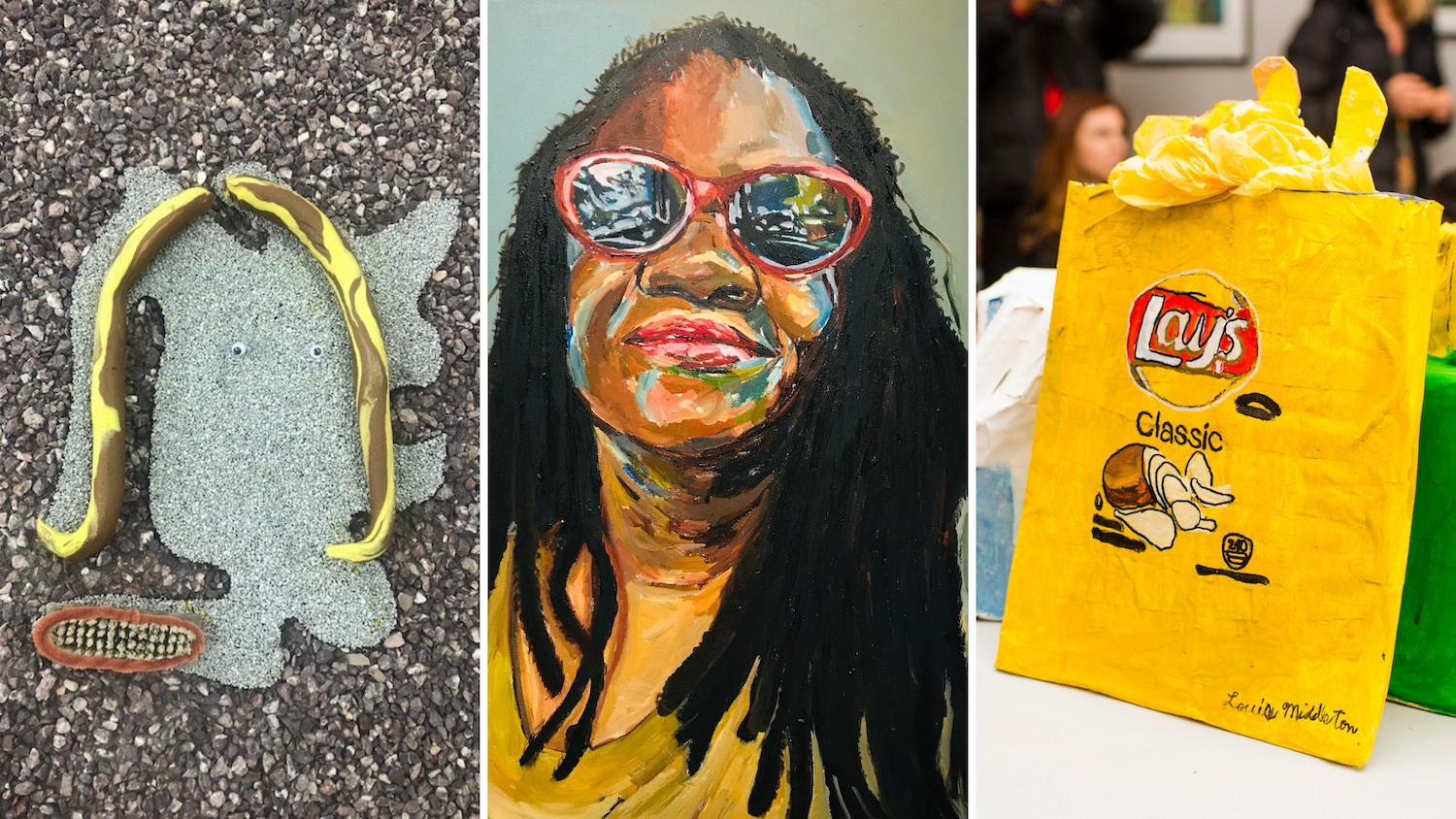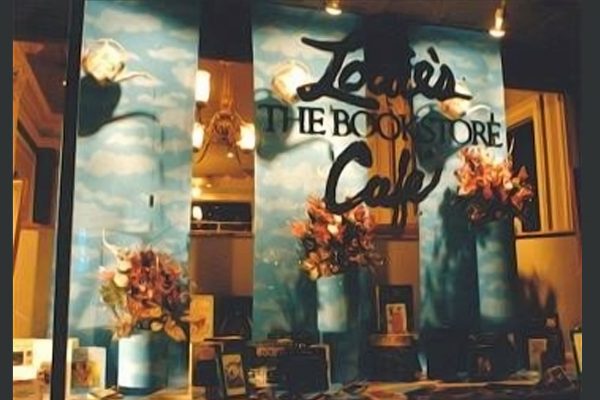The artist’s CulturalDC installation celebrates style and agency, addresses fashion industry exploitation
Each of Jamea Richmond-Edwards’ girls acts as a paper mirror, where the viewer can contemplate themselves as beautiful, Black, and eternally young. Their glowing gray skin, painstakingly rendered in ballpoint pen ink, has a subtle sheen that contains rainbow colors that only pop out if you look very close. The blurred treatment and strokes of the lines soften the otherwise angular planes of the girls’ faces. They represent the culture of Richmond-Edwards’ family, her own journey as an artist, and the tension between buying and creating.
The placement of vintage designer objects and garments (from fashion historian Desirée Venn Frederic’s archive) next to freshly made art forces a comparison; a part of me wishes that I could push all of the clothing away in order to see real beauty. But maybe that’s just the point—her family never needed the brands to be fly, because they had the inventiveness to create a new reality for themselves. Whether that ability was motivated more by necessity than pure creative exploration, the end result asserts that art and passion supersede all else. For Richmond-Edwards, style is tied to upward mobility, as well as expressing self-determination and respect.
Her newest solo show, Stay Fly is sponsored by CulturalDC and is currently located in the heart of Washington, DC near Metro Center station. CulturalDC’s executive director, Kristi Maiselman, has installed Stay Fly in a new concept that is reminiscent of the tiny home movement, the Mobile Art Gallery, merging artistic style with location accessibility.
“Stay Fly, being situated next to some of the most prominent design houses in the world, opens up the space for much-needed dialogue,” says Maiselman. “The Mobile Art Gallery platform provides an opportunity for artists to ask more from visitors. How can we hold each other accountable? When an artist is right outside those doors, their work as an answer to this question is deeply felt.”

Jamea Richmond-Edwards

Last month, Gucci, the flagship store of which happens to be the Mobile Art Lab’s current next-door neighbor, incited a great deal of controversy by releasing a golliwog sweater in their online store. The red-lipped and black-skin design on the sweater robs the stereotypical bit of personhood a golliwog would otherwise have—it has no eyes, no hair, no real reason to exist except to be worn on a foreign body.
In response to the dehumanization of minorities in American culture, Richmond-Edwards places European designer pieces next to her artwork. At times, the visual and spatial conversation overloads the senses, leaving the impression that the Mobile Art Gallery is a testing ground, rather than a fully realized execution, of cultural clash. However, this crush of space and purpose may reflect Richmond-Edwards’ own personal style of having many different, distinct elements tug of war for a viewer’s attention, fighting for the survival of the fittest.
You also can see this push and pull in her artistic process of applique and creating the delicate clash of textured fabrics and roughened papers, placing the muted tones of one bit along with the excitable patterns of several others. By installing designer items of mass production alongside her highly personal work, she addresses the dichotomy of Black people’s aspirations for brands that value cold cash over their customers’ personhood or heritage, and presents her unique set of alternatives to such problematic fashion.
“We are very aware of our collective consumer power, and perhaps some brands will take some major hits as a result of racist behavior. I think we’re beginning to catch on to their patterns,” Richmond-Edwards tells me in an email. “After the Gucci debacle… I went to every last [Black] designer’s website and almost all of them were sold out. If we’re not satisfied, many will take our dollars elsewhere.”

Close-up of installation (Photo by author)
There is a clear synthesizing of luxury signifiers in Richmond-Edwards’ work—such as the playful insertion of greenbacks, jewel-colored fringe, and finely detailed patterns on delicate papers—in direct contrast with the steady locus of each work: the solemn young girls in grayscale. The collaged and symbol-rich backgrounds are evocative of African rhythms, and the drama they contain forces viewers themselves to look inward. The girls in these drawings each have slightly distinctive features—a pointier nose here, wider-set eyes there—but they all look and indeed are related. “The subjects in my works are inspired by the women in my family who’ve always carried themselves in a noble way, which to me is very political,” Richmond-Edwards elaborates. “These are free women.”
Family ties and legacies play a crucial part in her installation. On the walls opposite the five pieces of work hang photographs of the artist at senior prom and her mother and aunts in the ‘80s and early ‘90s, all smiling and showing off the extent of their creativity and passion for life through their clothing—a swinging fringe head covering here, a custom-made cream satin prom dress there. Other cultural artifacts from that time line the walls beside the photos—a gorgeous sheer and red paneled negligee, floral Gucci sandals, a slick Moschino raincoat. When the artwork is alongside material goods, you can determine for yourself which mode of expression is superior, while also seeing how their colors, fabrics, and shapes share a common thread. There is a reason why these mass-produced designs hang alongside pictures of her family members in their own custom-made clothing: Richmond-Edwards means to demonstrate the exploitative relationship that high fashion has always had with inner-city trends.
“[W]hen I speak of the luxury style influences, I’m speaking of the aesthetics of Black Americana which essentially influences the world. Every season we see Black American aesthetics emerge on catwalks,” says Richmond-Edwards. “Where did designer houses get their inspiration from? Many of the aesthetics we tend to associate with European culture did not originate there!”

Close-up of mixed media artwork (Photo by author)
One example of fashion’s tendency to co-op Black culture is the recent case of Dapper Dan’s 1989 coat design for Olympic gold medalist Diane Dixon, which was recreated (originally without any credit) for Gucci’s F/W 2017 Milan Fashion Week show. Other examples abound: Jackie Kennedy’s wedding dress was made by Black designer Ann Lowe, who lost over $2,200 in making it and was only credited during her lifetime as a “colored woman”; even the blackface turtleneck most recently pulled from Gucci’s lineup could be called an imperfect copy of designer Patrick Kelly’s deliberately shocking work.
In Stay Fly, Richmond-Edwards shows love for her community and herself; through her art, she demonstrates that the true definition of luxury is agency over one’s own appearance and existence. In her show installation, you can track her very first sketches for her prom dress and journey on to her current style via her mixed media artworks, featured in Miami’s Rubell Collection and Fox’s Empire. Throughout her body of work, people from all walks of life can learn from her visual personification of freedom and expression. With her willingness to keep in motion and on-trend, she consistently manages to be in the right place at the right time.
Stay Fly is on view through April 13. For more information, visit CulturalDC’s website.
Photos: Header image by Kelvin Bulluck for the BmoreArt Journal: Issue 03, additional photos by Ryan Maxwell, except where otherwise noted.
This article has been updated to correct Desirée Venn Frederic’s title and contribution to the exhibition.






